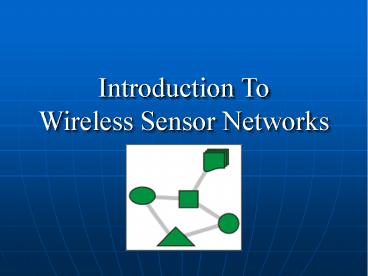Introduction To Wireless Sensor Networks - PowerPoint PPT Presentation
Title:
Introduction To Wireless Sensor Networks
Description:
... home automation, and traffic control. Sensor Node Networks of typically small, battery-powered, wireless devices. On-board processing, Communication, ... – PowerPoint PPT presentation
Number of Views:782
Avg rating:3.0/5.0
Title: Introduction To Wireless Sensor Networks
1
Introduction ToWireless Sensor Networks
2
Wireless Sensor Networks
- A wireless sensor network is a collection of
nodes organized into a cooperative network. Each
node consists of processing capability may
contain multiple types of memory have an RF
transceiver, have a power source (e.g., batteries
and solar cells), and accommodate various
sensors.
3
Wireless Sensor Networks
4
Communication Network
- A communication network is composed of nodes,
each of which has computing power and can
transmit and receive messages over communication
links, wireless or cabled.
5
Basic Network Topologies
- Star Topology
- Ring Topology
- Bus Topology
- Tree Topology
- Fully Connected Networks
- Mesh Networks
6
Star Topology
- All nodes of the star topology are connected to a
single hub node. The hub requires greater message
handling, routing, and decision-making
capabilities than the other nodes. If a
communication link is cut, it only affects one
node. However, if the hub is incapacitated the
network is destroyed.
7
Ring Topology
- In the ring topology all nodes perform the same
function and there is no leader node. Messages
generally travel around the ring in a single
direction. - However, if the ring is cut, all communication is
lost.
8
Bus Topology
- In the bus topology, messages are broadcast on
the bus to all nodes. Each node checks the
destination address in the message header, and
processes the messages addressed to it.
9
Tree Topology
- In Tree Topology there will be a root node and
the root node has two branches. Each branch may
again contains branches and so on.
10
Fully-connected Network
- In a fully connected Network when additional
nodes are added, the number of links increases
exponentially.
11
Mesh Network
- Mesh networks are regularly distributed networks
that generally allow transmission only to a
nodes nearest neighbors. The nodes in these
networks are generally identical.
Mesh nets can be good models for large-scale
networks of wireless sensors that are distributed
over a geographic region.
12
Communication Network
continue
- A single network may consist of several
interconnected subnets of different topologies.
Networks are further classified as Local Area
Networks (LAN), e.g. inside one building, or Wide
Area Networks (WAN), e.g. between buildings.
13
Wireless Sensor Networks
- A wireless sensor network (WSN) is a wireless
network consisting of spatially distributed
autonomous devices using sensors to cooperatively
monitor physical or environmental conditions,
such as temperature, sound, vibration, pressure,
motion or pollutants, at different locations.
14
Wireless Sensor Networks
continue
- The development of wireless sensor networks was
originally motivated by military applications
such as battlefield surveillance. However,
wireless sensor networks are now used in many
civilian application areas, including environment
and habitat monitoring, healthcare applications,
home automation, and traffic control.
15
Sensor Node
- Networks of typically small, battery-powered,
wireless devices. - On-board processing,
- Communication, and
- Sensing capabilities.
16
Sensor Node
continue
- In addition to one or more sensors, each node in
a sensor network is typically equipped with a
radio transceiver or other wireless
communications device, a small microcontroller,
and an energy source, usually a battery.
17
Sensor Node
continue
18
Sensor Node
continue
19
Sensor Network
Server
Sensor field
Gateway
Internet
20
Computer Revolution
MICAZ Mote (2005)
Original IBM PC (1981)
4 MHz
4.77 MHz
128 KB RAM
16-256 KB RAM
512 KB Flash
160 KB Floppies
35
6K (today)
14 mW
64 W
0.5 oz, 2.25 x 1.25 x 0.25 inch
25 lb, 19.5 x 5.5 x 16 inch
21
Sensor Network
Server
Watershed
Sensor field
Gateway
Internet
22
Network Model for WSN
- A wireless sensor network consists of hundreds or
thousands of low cost nodes which could either
have a fixed location or randomly deployed to
monitor the environment. The flowing of data ends
at special nodes called base stations (sometimes
they are also referred to as sinks).
23
Network Model for WSN
continue
- A base station links the sensor network to
another network (like a gateway) to disseminate
the data sensed for further processing. Base
stations have enhanced capabilities over simple
sensor nodes since they must do complex data
processing.
24
Network Model for WSN
continue
- This justifies the fact that bases stations have
workstation/laptop class processors, and of
course enough memory, energy, storage and
computational power to perform their tasks well.
25
Usage of Sensor Networks
- Environmental Observation
- Sensor networks can be used to monitor
environmental changes. An example could be water
pollution detection in a lake that is located
near a factory that uses chemical substances.
Sensor nodes could be randomly deployed in
unknown and hostile areas and relay the exact
origin of a pollutant. Other examples include
forest fire detection, air pollution and rainfall
observation in agriculture.
26
Usage of Sensor Networks
continue
- Military Monitoring
- Military uses sensor networks for battlefield
surveillance sensors could monitor vehicular
traffic, track the position of the enemy.
27
Usage of Sensor Networks
continue
- Building Monitoring
- Sensors can also be used in large buildings or
factories monitoring climate changes. Thermostats
and temperature sensor nodes are deployed all
over the buildings area. In addition, sensors
could be used to monitor vibration that could
damage the structure of a building.
28
Usage of Sensor Networks
continue
- Healthcare
- Sensors can be used in biomedical applications to
improve the quality of the provided care. Sensors
are implanted in the human body to monitor
medical problems like cancer and help patients
maintain their health.
29
- T h a n k Y o u































